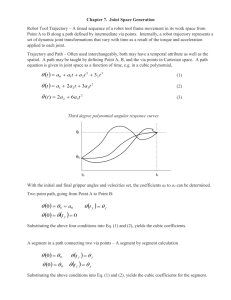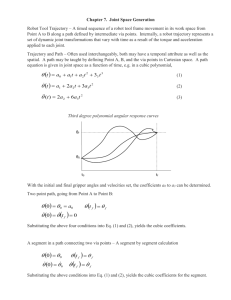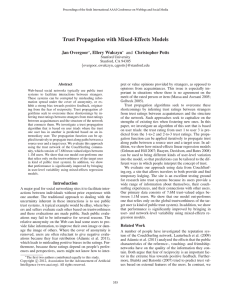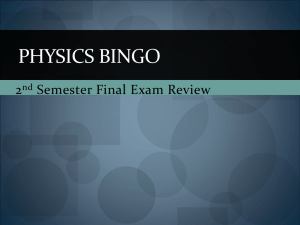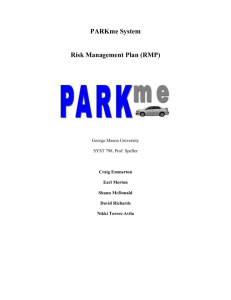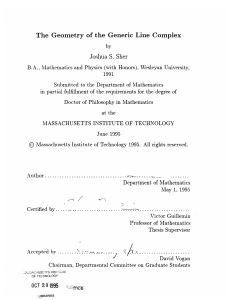CSULA- PHYSICS 211
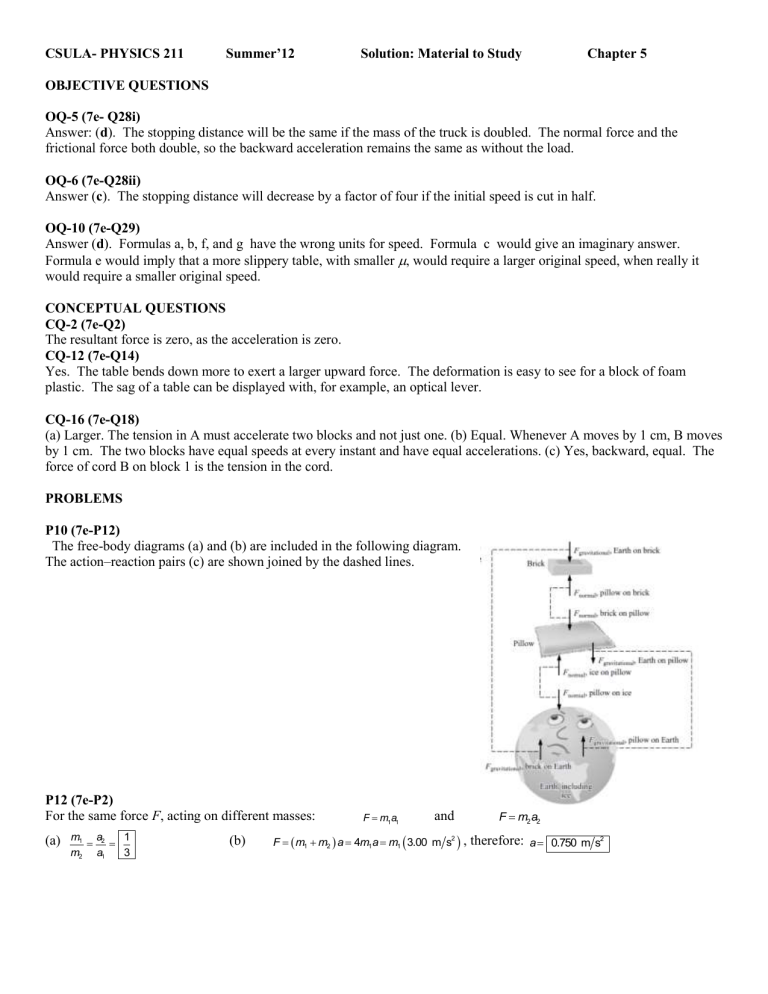
CSULA- PHYSICS 211
OBJECTIVE QUESTIONS
Summer’12 Solution: Material to Study Chapter 5
OQ-5 (7e- Q28i)
Answer: ( d ). The stopping distance will be the same if the mass of the truck is doubled. The normal force and the frictional force both double, so the backward acceleration remains the same as without the load.
OQ-6 (7e-Q28ii)
Answer ( c ). The stopping distance will decrease by a factor of four if the initial speed is cut in half.
OQ-10 (7e-Q29)
Answer ( d ). Formulas a, b, f, and g have the wrong units for speed. Formula c would give an imaginary answer.
Formula e would imply that a more slippery table, with smaller
, would require a larger original speed, when really it would require a smaller original speed.
CONCEPTUAL QUESTIONS
CQ-2 (7e-Q2)
The resultant force is zero, as the acceleration is zero.
CQ-12 (7e-Q14)
Yes. The table bends down more to exert a larger upward force. The deformation is easy to see for a block of foam plastic. The sag of a table can be displayed with, for example, an optical lever.
CQ-16 (7e-Q18)
(a) Larger. The tension in A must accelerate two blocks and not just one. (b) Equal. Whenever A moves by 1 cm, B moves by 1 cm. The two blocks have equal speeds at every instant and have equal accelerations. (c) Yes, backward, equal. The force of cord B on block 1 is the tension in the cord.
PROBLEMS
P10 (7e-P12)
The free-body diagrams (a) and (b) are included in the following diagram.
The action–reaction pairs (c) are shown joined by the dashed lines.
P12 (7e-P2)
For the same force F , acting on different masses:
(a) m
1 a m
2 a
1
2
1
3
(b)
F
m a
1 1
and F
m a
F
m
1
2
4 m a
1
m
1
3.00 m s
2
, therefore: a
0.750 m s
2
P19 (7e-P19)
(a) P cos 40
n = 0 and P sin 40
220 N = 0
P = 342 N and n = 262 N
(b) P
n cos 40
220 N sin 40
= 0 and n sin 40
220 N cos 40
= 0 n = 262 N and P = 342 N.
(c) The results agree. The methods are basically of the same level of difficulty. Each involves one
equation on one unknown and one equation in two unknowns. If we are interested in finding n
without finding P , method (b) is simpler.
P20 (7e-P23)
(a) Isolate either mass
T mg ma 0
T mg
The scale reads the tension T , so
T
mg
2
49.0 N
(b) The solution to part (a) is also the solution to (b).
T
2
2 T
1
0
(c) Isolate the pulley
T
2
2 T
1
2 mg 98.0 N
(a) and (b)
(d)
F n T m g
0
Take the component along the incline : n x
T x
mg x
0 sin 30.0
0 or
T mg sin 30.0
mg
2
2
0
24.5 N
(c)
P25 (7e-P21)
(d)
1
2
F g
T
1
1
T
3
2
T
2
P28 (7e-P26)
First, consider the block moving along the horizontal. The only force in the direction of movement is T . Thus,
F x
ma
T
5 kg
a (1)
Next consider the block that moves vertically. The forces on it are the tension T and its weight, 88.2 N. We have
F y
ma
88.2 N
9 kg
a (2) n
5 kg
T
+ x
49 N
T
9 kg
+ y
F g
= 88.2 N
Note that both blocks must have the same magnitude of acceleration. Equations (1) and (2) can be added to give
88.2 N
14 kg
a . Then: a
2
6.30 m s and T
31.5 N
P34 (7e-P32)
(a) Pulley P
1
has acceleration a
2
.
Since time, m
1 m
1
moves twice the distance P
1
has twice the acceleration of moves in the same
P
1
, i.e., a
1
2 a
2
.
(b) From the figure, and using
F ma :
2
m a
T
1
m a
T
2
2 T
1
0
2
Equation (1) becomes m g
2
2 T
1
m a
2 2
. This equation combined with Equation (2) yields:
T
1 m
1
T
1
m m
2
2 m
1
1
2 m
2 g
and
T
2
m
1 m m
2
1
4 m
2 g
(c) From the values of T
1
and T
2
we find that: a
1
T
1 m
1
2 m
1
1
2 m
2
and a
2
1
2 a
1
2 m
1
m
2
2
4 m
1
m
2
P46 (7e-P42)
Let a represent the positive magnitude of the acceleration
a
ˆ j of m
1
, of the acceleration
a i
ˆ
of m
2
, and of the acceleration
a j
ˆ
of m
3
. Call T
12 the tension in the left rope and T
23
the tension in the cord on the right.
For m
1
:
F y
ma y
T
12
1
1
For m
2
:
F x
ma x
T
12
k
23
And
F y
ma y for m
3
:
F y
ma y
0
T
23
m g
3
m a
3
We have three simultaneous equations:
T
12
T
12
T
23
39.2 N
4.00 kg
T
23
1.00 kg
19.6 N
2.00 kg
a a a
(a) Add them up:
39.2 N
7.00 kg
a , then: a
2.31 m s , down for m
1
, left for m
2
, and up for m
3
T
12
T
12
(b) Now
T
23
T
12
19.6 N
39.2 N
4.00 kg
2.31 m s 2
2.00 kg
2.31 m s 2
, therefore:
, then:
T
23
T
12
30.0 N
24.2 N
P47 (7e-P43)
(a)
(b)
See the figure adjoining
68.0
m g
m a
T
m g
1
m a
1
(Block #2)
(Block #1)
Adding,
68.0
m
1
m
1
a
68.0
m
1
m
2
g
T
m a
m g
1.29 m s 2
27.2 N
1 and m
1 m
1 n
1
= 118 N
T
T m
2 n
2
T
m
2
2
= 176 N
F n
F
T
23
T
23
P48 (7e-P44)
(a) To find the maximum possible value of P , imagine impending upward motion as case 1. Setting
f s , max
F x
0 : P cos50.0
n 0
s n : f s , max
s
P cos50.0
P 0.161
P
Setting
F y
0 : P sin 50.0
0.161
P
0
P max
48.6 N
To find the minimum possible value of P , consider impending downward motion. As in case 1, f s , max
0.161
P
Setting
F y
0 : P sin 50.0
0.161
P
0
P min
31.7 N
FIG. P5.44
(b) If P > 48.6 N, the block slides up the wall. If P < 31.7 N, the block slides down the wall.
(c) We repeat the calculation as in part (a) with the new angle.
Consider impending upward motion as case 1. Setting f
F x s , max
0 :
s n : f
P
cos13 n s , max
s
P cos13
0
P
0.244
P
Setting
F y
0 : P sin 13
0.244
P
0
P max
1580 N
The push cannot really be negative. However large or small it is, it cannot produce upward motion. To find the minimum possible value of P , consider impending downward motion. As in case 1, f s , max
0.244
P
Setting
F y
0 : P sin 13
0.244
P
0
P min
62.7 N
P
62.7 N. The block cannot slide up the wall. If P < 62.7 N, the block slides down the wall.
